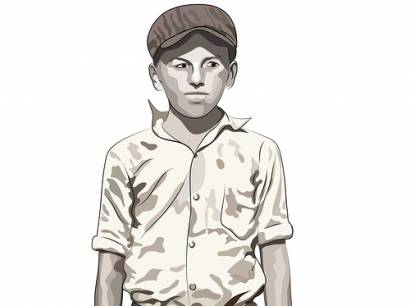This Week's Story
Maybe George W. Carver's hunger for education could lead him to schools. Maybe God existed and would help him.

This Week’s Story relives American history and the Bible through brief inspiring stories presented on mp3 audio recordings and text for reading.
The Gift of Possible, part two
A neighbor boy fell from a tree and broke both his legs. George started whittling and shaping a pair of crutches for him, using Uncle Moses Carver’s sharp hunting knife.
As George lay in bed one night he thought, “I wish I had my own knife. The things I could make!” In his sleep a peculiar dream came to him. He saw three stalks of corn, beside them a half-eaten watermelon, and beside it a pocketknife with two blades.
The next morning the dream was clear in his mind. He ran to the family’s cornfield. There was the same scene he had seen in his dream. He picked up the knife. It was real!
For days he kept the knife in his pocket, often touching it. Maybe dreams can come true. Maybe his hunger for an education could lead him to schools. Maybe God existed and would help him, even if he had to leave home to go to school.
One morning he did leave home, with his family sadly waving goodbye. He trudged eight dusty miles to Neosho, Missouri where he knew there was a schoolhouse. He would have to find some place to live.
While resting near a cabin, he met the owner, Mariah Watkins, and shared his wish to attend school. She replied, “You’re going to need a place to sleep.”
“I could help with the laundry and doctor your apple tree.”
“Yes, and you can rake the yard and feed the chickens.”
Soon he was living with the Watkins. During lunchtimes he went to their cabin by the schoolhouse. Hot water and soap would be waiting for him so he could scrub clothes, rinse and hang them on a clothesline. On Sundays he went to church, a church begun and run by ex-slaves. He had never gone to church before. He was given a small leather-bound Bible by Mrs. Watkins. He promised himself, “I will read it the rest of my life and find answers to my questions about God.”
Within a year at school George knew more than the other students and the teacher. The teacher had little education, because before the Civil War it was illegal in the South to teach a slave to read or write. There were few educated blacks in the South immediately after the war.
George was thirteen and told the Watkins, “I want to go to Fort Scott, Kansas. There’s a good high school there for black students.” Soon he was in Fort Scott either working for money to pay school expenses or going to school. Then two horrific events happened.
As he walked in town one day with his school notes and schoolbooks, which he had worked hard to pay for, two white men grabbed him. “See what happens to black boys who get too proud and steal books from white folks.” They destroyed his books and notes, kicking him repeatedly as he lay in a ball on the ground. White and black people walked by.
Then March 26, 1879 as George hid in a doorway, he saw a crowd of about a thousand people. Three of them wearing white masks dragged a black man to a lamppost. There they hung him, while men, women, and children cheered. His dead body was burned in a bonfire. George wondered, “Why wasn’t the man protected by the law?”
For months George wandered nervously throughout Kansas. At age nineteen he graduated from high school. His teachers urged him, “Go to college.” He applied to Highland College and was accepted. When he arrived, the principal harshly declared, “You did not tell me you were a Negro. This college does not accept Negroes.”
George turned away in a blur. Soon he had a new job, but no hope for his future.
This is Barbara Steiner anticipating the future of George Washington Carver. Please check out thisweeksstory.com.
<< previous story] [next story >>
We invite your comments! [click here to comment]
This Week's Story is a non-profit supported by listeners. [click here to make a donation]
 click here to play audio
click here to play audio